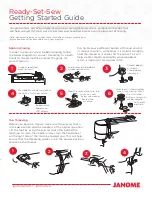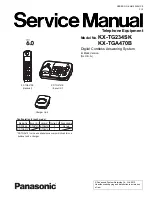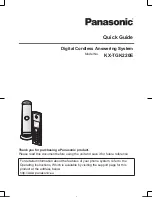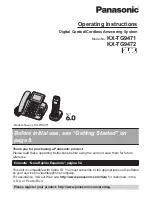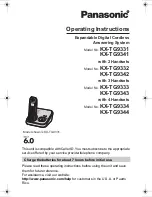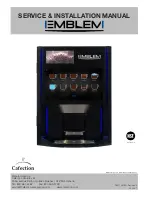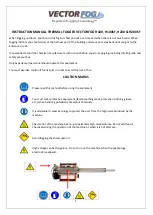
30
KX-FC265CX-S
6.6.
Modem Section
6.6.1.
Function
The unit uses a 1 chip modem (IC3) that serves as an interface between the control section for FAX transmission and reception
and the telephone line. During a transmitting operation, the digital image signals are modulated and sent to the telephone line.
During a receiving operation, the analogue image signals which are received via the telephone line are demodulated and con-
verted into digital image signals. The communication format and procedures for FAX communication are standardized by ITU-T.
This 1 chip modem (IC3) has hardware which sends and detects all of the necessary signals for FAX communication.
It can be controlled by writing commands from the CPU (IC10: inside ASIC) to the register in the modem (IC3).
This modem (IC3) also sends DTMF signals, generates a call tone (from the speaker), and detects a busy tone and dial tones.
Overview of Facsimile Communication Procedures (ITU-T Recommendation):
1. ON CCIT (International Telegraph and Telephone Consultative Committee)
The No. XIV Group of CCITT, one of the four permanent organizations of the International Telecommunications Union (ITU),
investigates and make recommendations on international standards for facsimiles.
2. Definition of Each Group
• Group I (G1)
Official A-4 size documents without using formats which reduce the band width of a signal are sent over telephone lines.Deter-
mined in 1968.
Transmission for about 6 minutes at a scanning line density of 3.85 lines/mm.
• Group II (G2)
Using reduction technology in the modulation/demodulation format, an A-4 size document is sent at an official scanning line den-
sity of 3.85 lines/mm for about 3 minutes.
Methods to suppress redundancy are not used.
Determined in 1976.
• Group III (G3)
Method of suppressing redundancy in the image signal prior to modulation is used. An A-4 size document is sent within about
one minute.
Determined in 1980.
• Group IV (G4)
Transmission is via the data network. A method is provided for suppressing redundancy in signals prior to transmission, and
error-free reception of transmission is possible.
The scope of these facsimile applications is not limited simply to transmission of written statements. Through symbiotic linkages
with other communication methods, it can be expected to expand to include integrated services.
Summary of Contents for KX-FC265CX-S
Page 20: ...20 KX FC265CX S 6 4 2 Block Diagram ...
Page 22: ...22 KX FC265CX S ...
Page 58: ...58 KX FC265CX S Note Refer to Program Mode Table P 99 ...
Page 66: ...66 KX FC265CX S 11 2 Cordless Handset ...
Page 69: ...69 KX FC265CX S 11 3 2 Service Mode Settings Note The above values are the default values ...
Page 77: ...77 KX FC265CX S Countermeasure ...
Page 78: ...78 KX FC265CX S REFERENCE Test Mode P 59 ...
Page 79: ...79 KX FC265CX S REFERENCE Test Mode P 59 ...
Page 80: ...80 KX FC265CX S REFERENCE Test Mode P 59 ...
Page 81: ...81 KX FC265CX S REFERENCE Test Mode P 59 ...
Page 82: ...82 KX FC265CX S ...
Page 83: ...83 KX FC265CX S REFERENCE Test Mode P 59 ...
Page 84: ...84 KX FC265CX S REFERENCE Test Mode P 59 ...
Page 88: ...88 KX FC265CX S ...
Page 113: ...113 KX FC265CX S ...
Page 120: ...120 KX FC265CX S I O and Pin No Diagram ...
Page 122: ...122 KX FC265CX S Other NG example while the power is ON and the LCD displays the following ...
Page 123: ...123 KX FC265CX S 12 5 5 2 NG Example ...
Page 127: ...127 KX FC265CX S 12 5 7 2 Troubleshooting Flow Chart ...
Page 133: ...133 KX FC265CX S 12 5 11 Thermal Head Section Note Refer to Thermal Head P 21 ...
Page 142: ...142 KX FC265CX S 13 Service Fixture Tools ...
Page 147: ...147 KX FC265CX S 14 3 Disassembly Procedure 14 3 1 How to Remove the Image Sensor CIS ...
Page 148: ...148 KX FC265CX S 14 3 2 How to Remove the Thermal Head ...
Page 149: ...149 KX FC265CX S ...
Page 150: ...150 KX FC265CX S 14 3 3 How to Remove the Bottom Frame ...
Page 151: ...151 KX FC265CX S 14 3 4 How to Remove the P C Boards and Speaker ...
Page 152: ...152 KX FC265CX S 14 3 5 How to Remove the Power Supply Board and AC Cord ...
Page 153: ...153 KX FC265CX S 14 3 6 How to Remove the Gear Block and Separation Roller ...
Page 154: ...154 KX FC265CX S 14 3 7 How to Remove the Gears Motors and Arms of the Gear Block ...
Page 155: ...155 KX FC265CX S ...
Page 156: ...156 KX FC265CX S 14 3 8 How to Remove the Charger Board A ...
Page 157: ...157 KX FC265CX S 14 3 9 How to Remove the Back Cover ...
Page 158: ...158 KX FC265CX S 14 3 10 How to Remove the Platen Roller and Lock Lever ...
Page 159: ...159 KX FC265CX S ...
Page 160: ...160 KX FC265CX S 14 3 11 How to Remove the Pickup Roller and Antenna ...
Page 161: ...161 KX FC265CX S 14 3 12 How to Remove the Operation Panel ...
Page 162: ...162 KX FC265CX S 14 3 13 How to Remove the Operation Board MIC Board and LCD ...
Page 163: ...163 KX FC265CX S 14 3 14 How to Remove the Separation Holder and Exit Roller ...
Page 164: ...164 KX FC265CX S 14 3 15 Installation Position of the Lead Wires 14 3 15 1 Lower Section ...
Page 165: ...165 KX FC265CX S ...
Page 166: ...166 KX FC265CX S ...
Page 167: ...167 KX FC265CX S ...
Page 168: ...168 KX FC265CX S 14 3 15 2 Operation Panel Section ...
Page 169: ...169 KX FC265CX S 14 3 15 3 Back Cover Section ...
Page 170: ...170 KX FC265CX S 14 3 16 How to Remove the Cordless Handset Board ...
Page 171: ...171 KX FC265CX S 14 3 16 1 How to Replace the LCD ...
Page 200: ...200 KX FC265CX S 17 1 7 Cordless Handset Board ...
Page 205: ...205 KX FC265CX S 17 4 Test Chart 17 4 1 ITU T No 1 Test Chart ...
Page 206: ...206 KX FC265CX S 17 4 2 ITU T No 2 Test Chart ...
Page 207: ...207 KX FC265CX S 17 4 3 Test Chart ...
Page 237: ...237 KX FC265CX S Memo ...
Page 239: ...239 KX FC265CX S Memo ...
Page 266: ...266 KX FC265CX S ...
Page 267: ...267 KX FC265CX S YK KXFC265CXS ...































